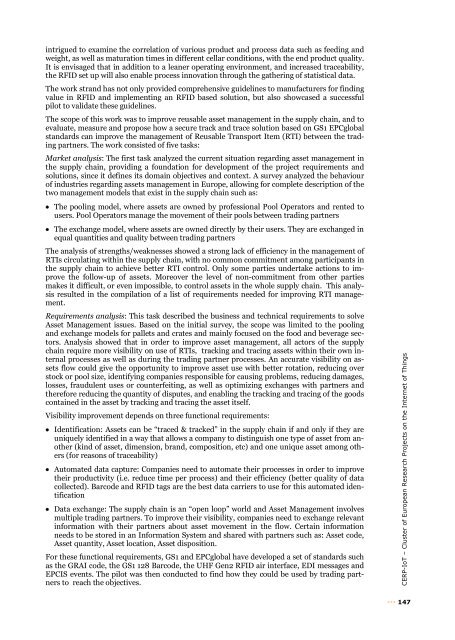Vision and Challenges for Realising the Internet of Things
Vision and Challenges for Realising the Internet of Things
Vision and Challenges for Realising the Internet of Things
Create successful ePaper yourself
Turn your PDF publications into a flip-book with our unique Google optimized e-Paper software.
intrigued to examine <strong>the</strong> correlation <strong>of</strong> various product <strong>and</strong> process data such as feeding <strong>and</strong><br />
weight, as well as maturation times in different cellar conditions, with <strong>the</strong> end product quality.<br />
It is envisaged that in addition to a leaner operating environment, <strong>and</strong> increased traceability,<br />
<strong>the</strong> RFID set up will also enable process innovation through <strong>the</strong> ga<strong>the</strong>ring <strong>of</strong> statistical data.<br />
The work str<strong>and</strong> has not only provided comprehensive guidelines to manufacturers <strong>for</strong> finding<br />
value in RFID <strong>and</strong> implementing an RFID based solution, but also showcased a successful<br />
pilot to validate <strong>the</strong>se guidelines.<br />
The scope <strong>of</strong> this work was to improve reusable asset management in <strong>the</strong> supply chain, <strong>and</strong> to<br />
evaluate, measure <strong>and</strong> propose how a secure track <strong>and</strong> trace solution based on GS1 EPCglobal<br />
st<strong>and</strong>ards can improve <strong>the</strong> management <strong>of</strong> Reusable Transport Item (RTI) between <strong>the</strong> trading<br />
partners. The work consisted <strong>of</strong> five tasks:<br />
Market analysis: The first task analyzed <strong>the</strong> current situation regarding asset management in<br />
<strong>the</strong> supply chain, providing a foundation <strong>for</strong> development <strong>of</strong> <strong>the</strong> project requirements <strong>and</strong><br />
solutions, since it defines its domain objectives <strong>and</strong> context. A survey analyzed <strong>the</strong> behaviour<br />
<strong>of</strong> industries regarding assets management in Europe, allowing <strong>for</strong> complete description <strong>of</strong> <strong>the</strong><br />
two management models that exist in <strong>the</strong> supply chain such as:<br />
The pooling model, where assets are owned by pr<strong>of</strong>essional Pool Operators <strong>and</strong> rented to<br />
users. Pool Operators manage <strong>the</strong> movement <strong>of</strong> <strong>the</strong>ir pools between trading partners<br />
The exchange model, where assets are owned directly by <strong>the</strong>ir users. They are exchanged in<br />
equal quantities <strong>and</strong> quality between trading partners<br />
The analysis <strong>of</strong> strengths/weaknesses showed a strong lack <strong>of</strong> efficiency in <strong>the</strong> management <strong>of</strong><br />
RTIs circulating within <strong>the</strong> supply chain, with no common commitment among participants in<br />
<strong>the</strong> supply chain to achieve better RTI control. Only some parties undertake actions to improve<br />
<strong>the</strong> follow-up <strong>of</strong> assets. Moreover <strong>the</strong> level <strong>of</strong> non-commitment from o<strong>the</strong>r parties<br />
makes it difficult, or even impossible, to control assets in <strong>the</strong> whole supply chain. This analysis<br />
resulted in <strong>the</strong> compilation <strong>of</strong> a list <strong>of</strong> requirements needed <strong>for</strong> improving RTI management.<br />
Requirements analysis: This task described <strong>the</strong> business <strong>and</strong> technical requirements to solve<br />
Asset Management issues. Based on <strong>the</strong> initial survey, <strong>the</strong> scope was limited to <strong>the</strong> pooling<br />
<strong>and</strong> exchange models <strong>for</strong> pallets <strong>and</strong> crates <strong>and</strong> mainly focused on <strong>the</strong> food <strong>and</strong> beverage sectors.<br />
Analysis showed that in order to improve asset management, all actors <strong>of</strong> <strong>the</strong> supply<br />
chain require more visibility on use <strong>of</strong> RTIs, tracking <strong>and</strong> tracing assets within <strong>the</strong>ir own internal<br />
processes as well as during <strong>the</strong> trading partner processes. An accurate visibility on assets<br />
flow could give <strong>the</strong> opportunity to improve asset use with better rotation, reducing over<br />
stock or pool size, identifying companies responsible <strong>for</strong> causing problems, reducing damages,<br />
losses, fraudulent uses or counterfeiting, as well as optimizing exchanges with partners <strong>and</strong><br />
<strong>the</strong>re<strong>for</strong>e reducing <strong>the</strong> quantity <strong>of</strong> disputes, <strong>and</strong> enabling <strong>the</strong> tracking <strong>and</strong> tracing <strong>of</strong> <strong>the</strong> goods<br />
contained in <strong>the</strong> asset by tracking <strong>and</strong> tracing <strong>the</strong> asset itself.<br />
Visibility improvement depends on three functional requirements:<br />
Identification: Assets can be “traced & tracked” in <strong>the</strong> supply chain if <strong>and</strong> only if <strong>the</strong>y are<br />
uniquely identified in a way that allows a company to distinguish one type <strong>of</strong> asset from ano<strong>the</strong>r<br />
(kind <strong>of</strong> asset, dimension, br<strong>and</strong>, composition, etc) <strong>and</strong> one unique asset among o<strong>the</strong>rs<br />
(<strong>for</strong> reasons <strong>of</strong> traceability)<br />
Automated data capture: Companies need to automate <strong>the</strong>ir processes in order to improve<br />
<strong>the</strong>ir productivity (i.e. reduce time per process) <strong>and</strong> <strong>the</strong>ir efficiency (better quality <strong>of</strong> data<br />
collected). Barcode <strong>and</strong> RFID tags are <strong>the</strong> best data carriers to use <strong>for</strong> this automated identification<br />
Data exchange: The supply chain is an “open loop” world <strong>and</strong> Asset Management involves<br />
multiple trading partners. To improve <strong>the</strong>ir visibility, companies need to exchange relevant<br />
in<strong>for</strong>mation with <strong>the</strong>ir partners about asset movement in <strong>the</strong> flow. Certain in<strong>for</strong>mation<br />
needs to be stored in an In<strong>for</strong>mation System <strong>and</strong> shared with partners such as: Asset code,<br />
Asset quantity, Asset location, Asset disposition.<br />
For <strong>the</strong>se functional requirements, GS1 <strong>and</strong> EPCglobal have developed a set <strong>of</strong> st<strong>and</strong>ards such<br />
as <strong>the</strong> GRAI code, <strong>the</strong> GS1 128 Barcode, <strong>the</strong> UHF Gen2 RFID air interface, EDI messages <strong>and</strong><br />
EPCIS events. The pilot was <strong>the</strong>n conducted to find how <strong>the</strong>y could be used by trading partners<br />
to reach <strong>the</strong> objectives.<br />
CERP-IoT – Cluster <strong>of</strong> European Research Projects on <strong>the</strong> <strong>Internet</strong> <strong>of</strong> <strong>Things</strong><br />
147
















